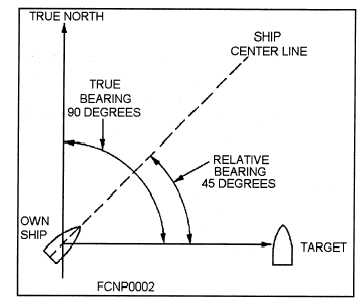Given the range information, the operator knows
the distance to an object, but information on bearing
is still required to determine in which direction from
the ship the target lies.
Bearing
Radar bearing is determined by the echo signal
strength as the radiated energy lobe moves past the
target. Since search radar antennas move contin-
uously, the point of maximum echo return is deter-
mined either by the detection circuitry as the beam
passes the target or visually by the operator. Weapons
control and guidance radar systems are positioned to
the point of maximum signal return and are main-
tained at that position either manually or by automatic
tracking circuits.
TRUE BEARING.— The angle between true
north and a line pointed directly at a target is called
the true bearing (referenced to true north) of a radar
target. This angle is measured in the horizontal plane
and in a clockwise direction from true north.
RELATIVE BEARING.— The angle between
the centerline of your ship or aircraft and a line
pointed directly at a target is called the relative bear-
ing of the radar target. This angle is measured in a
clockwise direction from the centerline. Most surface-
search radars provide only range and bearing infor-
mation. If the operator were to have a need to direct
air traffic or to track incoming missiles, the radar
would also have to provide altitude. Both true and
relative bearing angles are illustrated in figure 1-2.
Altitude
An operator can determine the altitude of a target
by adjusting a movable height line on a height indica-
tor to the point where the line bisects the center of the
target. The altitude is then displayed by an altitude
dial or a digital readout. A search radar system that
Figure 1-2.—True and relative bearings.
detects altitude as well as range and bearing is a three-
dimensional (3-D) radar.
Altitude or height-finding radars use a very nar-
row beam in the vertical plane. This beam is scanned
in elevation, either mechanically or electronically, to
pinpoint targets. Tracking and weapons-control radar
systems commonly use mechanical elevation scanning
techniques that require mechanically moving the an-
tenna or the radiation source.
Most air-search radars use electronic elevation
scanning techniques. Some older air-search radar sys-
tems use a mechanical elevation scanning device;
however, these are being replaced by electronically
scanning radar systems.
RADAR DETECTING METHODS
Radar systems are normally divided into opera-
tional categories based on energy transmission meth-
ods. Although the pulse method is the most common
method of transmitting radar energy, two other meth-
ods are sometimes used in special applications. These
are the continuous-wave method and the frequency-
modulation method.
1-4


